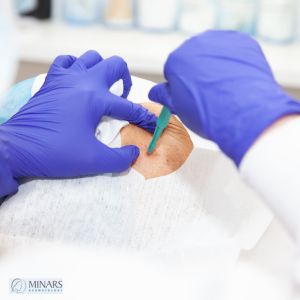When a suspicious spot appears on your skin, one of the most important steps in diagnosis is a skin biopsy. At our Hollywood dermatology clinic, we strive to ensure that our patients understand this procedure, allowing them to feel comfortable and informed throughout the process.
What Is a Skin Biopsy?
A skin biopsy involves removing a small sample of skin tissue for examination under a microscope. This allows us to determine if a lesion is cancerous, precancerous, or benign. There are several types of biopsies, including shave biopsies, punch biopsies, and excisional biopsies, each suited to different situations.
How Is the Biopsy Performed?
Before the biopsy, the area is cleaned and numbed with a local anesthetic so you won’t feel pain during the procedure. Depending on the size and location of the lesion, we may remove the entire spot or just a portion of it. The procedure typically takes just a few minutes.
After removal, the biopsy site will be covered with an ointment and a bandage. You might have a small sore or scab while it heals. It’s important to keep the area clean and dry, and avoid picking at it to prevent infection and scarring.
When Will You Get the Skin Biopsy Results?
The tissue sample is sent to a pathology lab, where a specialist examines it. This process typically takes between one and two weeks. We will contact you as soon as the results are in to discuss the findings and the next steps.
What Happens If the Biopsy Shows Skin Cancer?
If the biopsy confirms skin cancer, we will work with you to develop a personalized treatment plan. The approach depends on the type, size, and location of the cancer. Treatment options might include surgical removal, curettage and electrodessication (“scrape and burn”), or Mohs surgery for more precise removal.
Sometimes, further testing or specialist referral is needed, especially if melanoma is diagnosed. Early detection and treatment are critical for the best outcome.
What Are the Risks of a Biopsy?
Skin biopsies are generally safe, but as with any procedure, there are some risks. These include bleeding, infection, scarring, or changes in skin color at the biopsy site. We take every precaution to minimize these risks and provide instructions to help you care for the site at home.
Why Is a Biopsy Necessary?
While some skin cancers have typical appearances, others can be subtle or mimic benign lesions. A biopsy provides a definitive diagnosis and prevents unnecessary treatments or delays in care. If you notice a new, changing, or suspicious spot on your skin, don’t hesitate to get it evaluated. A biopsy is a simple, quick, and essential tool in skin cancer diagnosis. Early detection saves lives and allows for effective, minimally invasive treatment.










